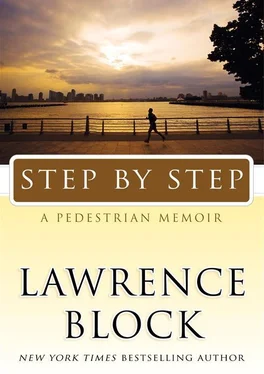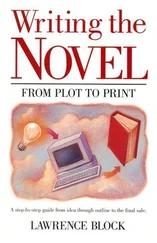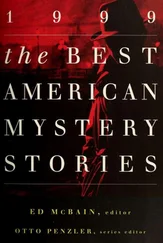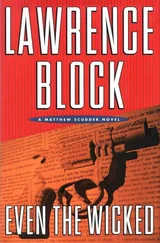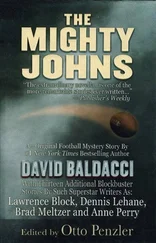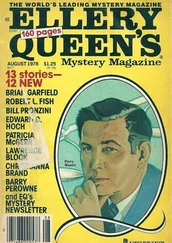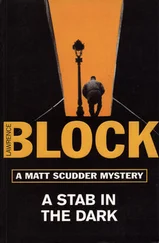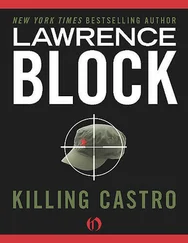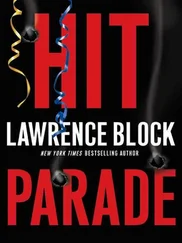Lawrence Block - Step by Step
Здесь есть возможность читать онлайн «Lawrence Block - Step by Step» весь текст электронной книги совершенно бесплатно (целиком полную версию без сокращений). В некоторых случаях можно слушать аудио, скачать через торрент в формате fb2 и присутствует краткое содержание. Год выпуска: 2009, ISBN: 2009, Издательство: William Morrow, Жанр: Биографии и Мемуары, Юмористические книги, на английском языке. Описание произведения, (предисловие) а так же отзывы посетителей доступны на портале библиотеки ЛибКат.
- Название:Step by Step
- Автор:
- Издательство:William Morrow
- Жанр:
- Год:2009
- ISBN:978-0-06-172181-6
- Рейтинг книги:3 / 5. Голосов: 1
-
Избранное:Добавить в избранное
- Отзывы:
-
Ваша оценка:
- 60
- 1
- 2
- 3
- 4
- 5
Step by Step: краткое содержание, описание и аннотация
Предлагаем к чтению аннотацию, описание, краткое содержание или предисловие (зависит от того, что написал сам автор книги «Step by Step»). Если вы не нашли необходимую информацию о книге — напишите в комментариях, мы постараемся отыскать её.
bestselling author comes a touching, insightful, and humorous memoir of an unlikely racewalker and world traveler.
Step by Step — читать онлайн бесплатно полную книгу (весь текст) целиком
Ниже представлен текст книги, разбитый по страницам. Система сохранения места последней прочитанной страницы, позволяет с удобством читать онлайн бесплатно книгу «Step by Step», без необходимости каждый раз заново искать на чём Вы остановились. Поставьте закладку, и сможете в любой момент перейти на страницу, на которой закончили чтение.
Интервал:
Закладка:
That got me through two more laps, but I could tell I wasn’t going to be able to keep at it much longer. The sun was higher in the sky, the heat was mounting, and my feet were hurting me, moleskin or no moleskin. I sank into a chair after the eighth lap and had a chat with Glen Mizer, whom I hadn’t seen since we’d both struggled through the New Orleans race back in February. He lived in the area, and would be starting the six-hour race in a little while.
I forced myself back on the course, wondering when I could let myself give up.
Just now, writing this, I poked around online and found my lap times for the Ultracentric. I’d started off slowly, walking 15:32-minute miles, and I’d only gotten slower as the race wore on. By the tenth lap I slowed to a stroll, and at its end I’d taken five hours and thirty-eight minutes to go an even twenty miles. My feet bothered me during the seventh and eighth laps, and I’d really had to force myself through laps nine and ten, and when the tenth lap was finished, so was I.
I announced as much during my final lap to Ollie, and to Dave Gwyn, who was one of the four Centurion judges for the walkers. Both pointed out that it was in fact a twenty-four-hour race, and that if I was hurting I could certainly quit the course for a long break and come back later on. Why, I wondered, were they telling me this? What made them think I could possibly want to return?
I got in my car, drove to my hotel. I bought two liters of Coca-Cola from the vending machine in the lobby, called Domino’s from my room, and drank one bottle while I waited for them to bring the pizza and the other between slices. I turned on the TV, found a football game.
At some point I took off my shoes and socks and checked my feet. I decided they didn’t look too bad. And I realized they’d pretty much stopped hurting as soon as I left the course.
29
Six walkers qualified as american centurions at the Ultracentric that year, three from the Netherlands, one from Australia, and two Americans. A Belgian was seventh, at sixty-two miles; then an American at sixty, and two more, one of them Ollie, at fifty-eight. The sole woman walker in the race was an American who wins events of this sort here and in Europe almost routinely; this time she had an off day, and quit after eighteen miles.
I went home, tossed my dirty clothes in the laundry basket, and hung up my Ultracentric sweatshirt. It was a presentable garment, it even had a hood, and it made a nice change from all those T-shirts, but I couldn’t imagine what would prompt me to wear it. I didn’t want something to help me remember that race. I’d have been more grateful for help forgetting it.
First, though, I wanted to get it down before I did in fact forget it, and I spent a string of mornings pecking away at my computer. I’d left off writing the book — this book, that is to say — a little ways past the conclusion of the pilgrimage to Santiago, and now I skipped ahead and wrote about what I’d just gone through. It wasn’t much fun, and after a few days and a few thousand words, and hardly anything about the race itself but no end of lamenting the weeks preceding it, I gave it up. I told myself I’d get back to it in a while, and then I began to wonder if that was true. Maybe I was done with it.
Maybe I was done with walking.
It did look that way. I didn’t much welcome the thought, but it was impossible to dismiss it out of hand. Writing about my preparation for the Ultracentric — or, more to the point, my lack thereof — I’d been struck by the manner in which I’d deliberately (if unconsciously) sabotaged myself. After weeks of intensive training, high-mileage weeks marked by walks of marathon length and longer, I’d abruptly pulled the plug on training and made sure I showed up at the start of the race in the worst possible condition. Just as I’d walked through twenty miles looking forward to the opportunity to quit, so I’d spent the weeks leading up to the race working to guarantee myself such an opportunity.
When I looked back at the year, all I seemed to see was a mix of pain and disappointment and failure. I could find ways to regard my performances at Huntington Beach and New Orleans as heroic, simply for having persisted to the end in spite of the pain. That was one way to look at it, but in the end those were hard races, pain-filled races, and the only pleasure they’d held lay in their having finally ended. Wakefield had been a disaster this time, and the best I could say about it was that I’d been lucky enough to be off the course when it got rained out. And the Ultracentric, well, it had become a failure and a disappointment for me before it had even begun.
I’d resumed racing in January of 2005, and in three years I’d taken part in fifty-two races, including eleven marathons and seven ultras. My list of states in which I’d walked a marathon or ultra stood at fourteen, plus England, Spain, and Canada.
Maybe that was enough.
After all, it wouldn’t be the first time I’d stopped. My enthusiasms are often intense, but they tend to be impermanent. I throw myself into them, and they run their course, and the day comes when they no longer hold much interest for me. I could regret this trait, and sometimes did, but it seemed to be the way I was.
I had, after all, been a runner and walker years ago, and trained relentlessly, and entered races obsessively. And then I’d stopped, only to resume in time with as much passion and commitment as I’d ever brought to the sport. If my ardor cooled, I could stop; when the time was right, I could take it up again.
Oh, really? Another twenty-five-year break would have me lacing up my Sauconys at age ninety-four. The good news, I suppose, is that I’d generally win my age group. Assuming I could remember how to walk.
While the rest of 2007 ran out, I mostly sat around and watched it go. I wasn’t working on this book or on anything else. I wasn’t walking along the Hudson, or showing up at the gym.
What I felt, when I felt anything at all, was a sort of lingering sadness, backed with a measure of dread. That I was apparently discontinuing a practice of walking enormous distances was not alarming all by itself, but it became unsettling in context. Because I could then see it as the next item in a lengthening list of activities that no longer held much joy for me. And several of them were not the sort of transient enthusiasms one routinely picks up and sets down. They were lifelong pleasures that of late had ceased to be pleasurable.
Reading, for instance. I’d been a reader almost as long as I’d been a walker, and it was my strong response to fiction that did much to incline me toward writing it. Over the past decade or so, I’d discovered that it rarely worked for me anymore.
The work I’d been doing for a half century bore some responsibility. Spend your days making sausage and it will reduce your appetite for the product. I’d become overly attuned to how words and sentences were strung together and how stories unfolded, and that made it harder for me to get caught up in what I read.
Age, too, undercut one of fiction’s roles. In my youth, one of the functions of the novels I read was that of explaining the world to me; as I grew up, I required less in the way of explanation and resisted a worldview helpfully supplied by some bright young thing fresh out of the Iowa Writers’ Workshop.
I could still immerse myself in a book now and then, but it was apt to be by some writer I’d been reading for years, and it helped if I was a captive audience — stuck in a hotel room or a ship’s cabin, say, with time on my hands and nothing much else to fill it with. Most of the time, though, I’d pick a book up and read a few chapters and lose interest. I’d know where the author was going with this, and saw no reason why I had to keep him company. Or I’d get halfway through the thing and set it down with every intention of finishing it, only to find that I never had the slightest interest in picking it up again.
Читать дальшеИнтервал:
Закладка:
Похожие книги на «Step by Step»
Представляем Вашему вниманию похожие книги на «Step by Step» списком для выбора. Мы отобрали схожую по названию и смыслу литературу в надежде предоставить читателям больше вариантов отыскать новые, интересные, ещё непрочитанные произведения.
Обсуждение, отзывы о книге «Step by Step» и просто собственные мнения читателей. Оставьте ваши комментарии, напишите, что Вы думаете о произведении, его смысле или главных героях. Укажите что конкретно понравилось, а что нет, и почему Вы так считаете.
